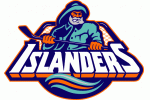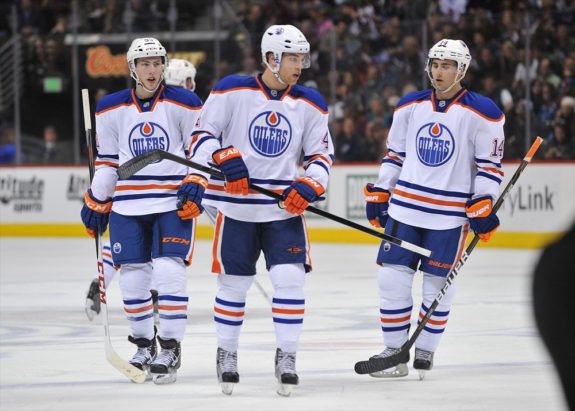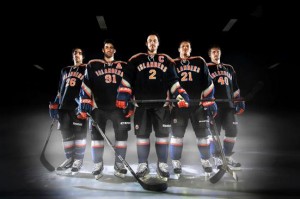Futility Part Three: Dud Dynasties
In this final installment of Hockey Futility, we look at two franchises that were once on the top of the NHL map so many decades ago. There was no great rivalry when a group of up and coming superstars challenged the great champions of that era than the Edmonton Oilers and the New York Islanders.
It has been thirty years since two of the NHL’s biggest franchises went head to head for the most coveted prize of all, the Stanley Cup. In the 1983 Cup Final, the Oilers and the Islanders met, and it was expected that the young Oilers would take the championship away from an aging champion from Long Island, NY. What happened in that final was shocking for some. Having been shellacked by the experienced Islanders in a clean sweep, the Oilers took the loss hard but found it what it took to be a true champion. As expected, the Oilers defeated the Islanders in the 1984 Final, and did so with dominance thanks to Mark Messier, the Conn Smythe MVP.
Stories from that historic playoff rivalry:
While one team was going on the uphill slope, the other is slowly moving downhill. It was when legends like Mike Bossy, Bryan Trottier and Billy Smith left the game that the Islanders were no longer regarded as Stanley Cup favorites. Long Island’s best days were clearly behind them.
Meanwhile, the Oilers enjoyed four championships of their own in the 1980s, culminating in the big Gretzky trade in 1988 and then grabbing one more without The Great One in 1990. It wasn’t long before Wayne Gretzky’s teammates would soon follow suit and leave Edmonton for greener pastures. Furthermore, it wouldn’t be long to find the Oilers in the basement for most of the 1990s, including a scare in 1998 when the local ownership group purchased the Oilers from Peter Pocklington who had hinted moving the team from Edmonton during the sale.
Escape from Exile Island
Since 1984, the Islanders were clearly on their way to mediocrity, and would be in the middle of hockey purgatory for a very long time. Despite that shocking run in the 1993 playoffs, the Islanders hovered in the lower echelon in the Wales/Eastern Conferences, starting with that hideous Captain Highliner marketing nightmare, and culminating in the brutal Milbury Era.

After a five-year hiatus, the Isles were back in the postseason, almost shocking the heavily favored Pittsburgh Penguins in the 2013 Conference Quarter Final. Just think, what would have happened if the underdog was able to pull that off? Despite falling short, the Islanders have proved to the hockey world that Long Island was a threat. Look at what they did to poor Marc-Andre Fleury.
Under head coach Jack Capuano for the last few seasons of anguish and plenty of patience, and led by John Tavares who may be the next captain after the recent trade the rights of Mark Streit to the Philadelphia Flyers, the Islanders have certainly proven their worth with fans. They’ve returned to the Nassau Coliseum, knowing that there’s only a few seasons left before the team moves to Barclays Center in Brooklyn for 2015-16. Let’s hope during this short remaining period in Uniondale that the support for New York’s underdog team can carry the Isles to prominence once again.
Same Old Song And Dance in Edmonton
While it appears that the Islanders have regained some solid seasonal form and return to the playoffs, the Oilers on the other hand haven’t even come close. Compare the Oilers to this season’s Toronto Blue Jays: The Jays made some major off-season blockbuster trades and signed some significant stars prior to the 2013 MLB season. Every major sports network and sportswriter in Canada predicted a big season for Toronto so much so, that they were touted to be one of the favorites to win the World Series. Fast forward to today, and you’ll see the Blue Jays rank dead last in the American League East, 11 games back of the Boston Red Sox. What is Toronto’s problem? They’re being overhyped.

That’s been a consistent problem for the Oilers since that Cinderella run to the 2006 Cup Final. Everyone, Edmonton fans and media alike, expected big things to come out of the Oilers. What thought to be high expectations turned out to be realistic shortfalls, therefore the Oilers are being overhyped. Everyone forgets that the 2006 squad slipped in the 8th and final playoff spot, squeezing past the Vancouver Canucks who were expected to be in the second season.
Year after year since 2007, the Oilers never ceased to disappoint the hockey gods. After so much promise, so much drafted talent, and so many managerial and coaching changes, the Oilers still can’t seem to get it right. Despite picking a good crop of talent in recent entry drafts, the team fared no better than dead last or near dead last in the Western Conference. Even with Jordan Eberle, Taylor Hall, Ryan Nugent-Hopkins and Nail Yakupov, the Oilers once again didn’t get out of the conference basement.
The Oilers fired rookie coach Ralph Krueger after only one short season behind the bench, just replaced by highly-touted yet unproven AHL coach Dallas Eakins. This is a reminder of the pitfalls that the Oilers made after the 1994-95 NHL Lockout. GM Glen Sather brought in poor George Burnett to take over the coaching reins, only to discover that the veteran roster tuned him out, especially Shayne Corson who had his captaincy stripped.
The fans will continue to be frustrated and with the City of Edmonton on the hook in a new agreement with the Oilers to build a new arena in Downtown Edmonton in time for the 2016-17 season. Perhaps by then the Oilers may be back in the playoffs for the first time since 2006.
However long it may take, both Edmonton and Long Island, both who were once great hockey dynasties, will have to find a way to return to the glory and supremacy that local fans had enjoyed, because if they don’t that magic may fade away forever.
These are small market teams that have plenty to lose if they don’t improve. If it stays like this, then the fans won’t come back to the rink, lockout or not.
